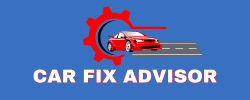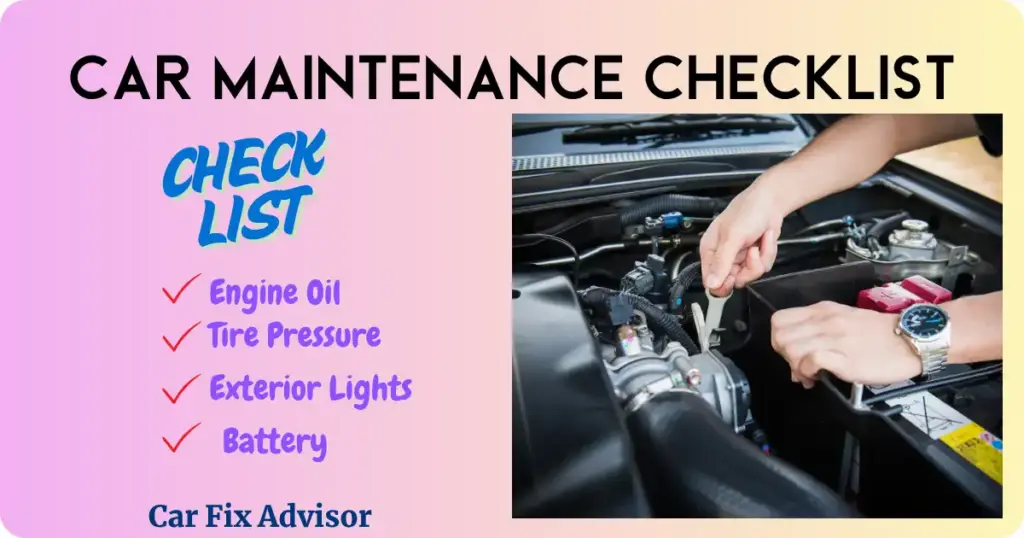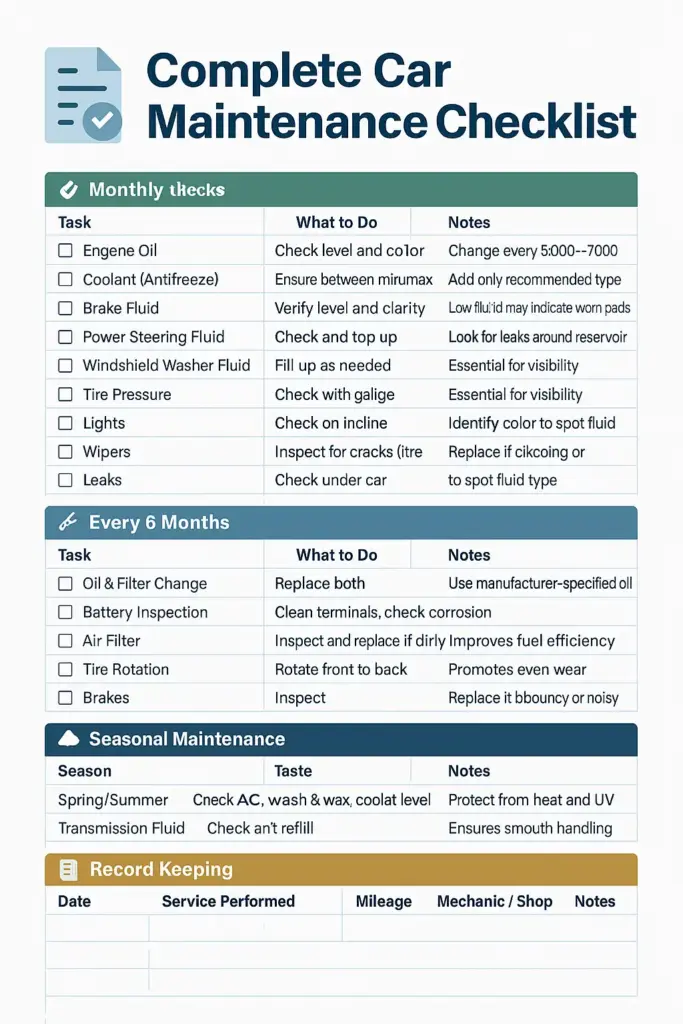A reliable car isn’t just about horsepower or style — it’s about how well you care for it.
A car maintenance checklist helps you stay on top of essential inspections and tune-ups that prevent breakdowns, improve fuel efficiency, and extend your vehicle’s life.
Neglecting small things like oil levels, tire pressure, or brake condition can lead to expensive repairs later. Whether you’re a seasoned driver or a first-time car owner, this complete maintenance guide will help you keep your car running smoothly all year long.
Why Regular Car Maintenance Matters
Taking a few minutes each month to check your vehicle can save you hours of stress down the road. Proper car maintenance ensures:
- Safety: Reliable brakes, lights, and tires prevent accidents.
- Cost savings: Regular upkeep avoids major repair bills.
- Better performance: A well-maintained engine delivers better fuel economy.
- Longevity: Regular care extends your car’s lifespan.
- Higher resale value: Buyers pay more for well-maintained cars.
How Often Should You Do Car Maintenance?
- Monthly: Fluids, lights, and tire pressure.
- Every 6 months: Oil change, battery inspection, air filter check.
- Annually: Full inspection, brake service, coolant flush, spark plug check.
The Complete Car Maintenance Checklist
Your car has dozens of moving parts working together. A quick check every few weeks helps prevent unexpected issues. Let’s break it down.
1. Fluids – Keep Your Engine Healthy
Fluids are the lifeblood of your vehicle. Running low or using dirty fluids can cause serious engine damage.
- Engine Oil:
Check when the engine is off and cool. The oil should be clean and at the right level. Change both oil and filter as recommended (usually every 5,000–7,000 miles). - Coolant (Antifreeze):
Prevents overheating in summer and freezing in winter. Make sure the coolant in the overflow tank is between the min/max marks. - Brake Fluid:
A low level could mean your brake pads are wearing out. Replace as needed to keep braking power consistent. - Power Steering Fluid:
Low fluid can make steering stiff or noisy. Check and top up if necessary. - Windshield Washer Fluid:
Keep it full for clear visibility — especially during dusty or rainy seasons.
Quick Tip: If you notice any leaks under your car, place a cardboard sheet overnight to identify the fluid color — it helps you detect issues early.
2. Tires – Safety and Performance Check
Your tires connect you to the road, so their condition directly affects safety and comfort.
- Tire Pressure:
Check with a pressure gauge at least once a month. Under-inflated tires reduce mileage and wear out faster. - Tread Depth:
Use the penny test — insert a penny into the tread with Lincoln’s head upside down. If you can see his head, it’s time to replace the tires. - Tire Rotation:
Rotate every 5,000–7,000 miles for even wear and smoother handling. - Spare Tire & Jack:
Make sure the spare is inflated and your toolkit is complete before any long trip.
3. Lights and Visibility – Don’t Drive Blind
Good visibility is non-negotiable when it comes to safety. Faulty headlights or worn-out wipers can make driving dangerous — especially at night or during heavy rain.
Here’s what to check:
- Exterior Lights:
Test your headlights (both low and high beams), brake lights, turn signals, and reverse lights once a month.
Pro Tip: Park in front of a wall and turn on your lights — it’s an easy way to spot misalignment. - Wipers:
Replace the blades every 6–12 months or when you notice streaks. Clear visibility can literally save lives during a storm. - Windshield and Mirrors:
Check for cracks or chips and repair them early. Tiny cracks can expand quickly with temperature changes. - Horn:
Ensure it’s loud and consistent. It’s your best tool for alerting other drivers.
Maintenance Bonus: A quick glass cleaner wipe on all mirrors and windshields improves clarity and reduces glare at night.
4. Under the Hood – Essential Inspections
Pop the hood and take a minute to inspect the core systems that keep your engine running strong. Even if you’re not a mechanic, simple visual checks go a long way.
- Battery:
Look for corrosion on the terminals and ensure connections are tight. Clean the terminals with baking soda and water if needed. - Belts & Hoses:
Examine for cracks, fraying, or leaks. These parts wear down with heat and age — a broken belt can leave you stranded. - Engine Air Filter:
A clogged air filter reduces fuel efficiency. Replace it every 12 months or 12,000 miles. - Leaks:
Oil or coolant puddles under your car signal trouble. Catching leaks early prevents costly engine damage.
Tip: Keep a small flashlight in your glove box — it’s perfect for quick under-hood inspections anytime.
5. Inside the Cabin – Comfort and Safety
Your car’s interior isn’t just about comfort; it plays a key role in overall safety.
- Cabin Air Filter:
Keeps dust, pollen, and pollution out. Replace it annually or as recommended by your manufacturer. - Seatbelts:
Pull them sharply to check the retraction and ensure the buckles latch securely. - Handbrake / Parking Brake:
Engage it on a slope — it should hold the car firmly without slipping. - Dashboard Warning Lights:
Don’t ignore them. A check engine or oil pressure light often signals an issue that needs immediate attention.
Pro Tip: Keep a copy of your owner’s manual handy — it explains every dashboard icon and what action to take.
6. Brakes – Your Primary Safety System
Your brakes are your car’s most crucial safety feature. If you hear squealing, grinding, or notice a longer stopping distance — it’s time for a check-up.
- Brake Pads & Rotors:
Inspect for thinning pads or grooves in rotors. Replace pads before they’re fully worn to prevent rotor damage. - Brake Fluid:
Check the level regularly. It should be clear to light yellow — dark or cloudy fluid means it’s time to replace it. - Emergency Brake:
Ensure it engages and releases smoothly.
Quick Reminder: If your car pulls to one side when braking, visit a mechanic immediately — it could mean uneven pad wear or hydraulic issues.
7. Seasonal Car Maintenance Tips
Your car’s needs change with the seasons. A few small adjustments can help you handle everything from summer heat to winter snow.
Spring & Summer Maintenance
After a long winter, your car deserves a refresh.
- Check the A/C System:
Test air conditioning performance and recharge refrigerant if the airflow feels weak. - Inspect Coolant Levels:
Prevent overheating on long summer drives by checking the coolant in your radiator and overflow tank. - Wash and Wax:
Road salt and grime can eat away at paint. A good wax adds protection against UV rays and debris.
Fall & Winter Maintenance
Cold weather can be brutal on your vehicle — prepare before the first frost.
- Switch to Winter Tires:
They grip better in snow and ice, keeping you safer. - Battery Health Check:
Extreme cold reduces battery efficiency. Have it tested or replaced if it’s over 3 years old. - Check Antifreeze Mix:
Maintain a 50/50 water and antifreeze ratio to prevent freezing. - Replace Wiper Blades:
Use winter wipers for better performance in icy or snowy conditions.
8. Long-Term Car Maintenance Tasks (Every 6–12 Months)
Some maintenance jobs don’t need to be done often, but they’re crucial for keeping your car reliable long-term.
- Oil & Filter Change: Every 5,000–7,000 miles or as per manual.
- Tire Rotation and Balancing: To ensure even tread wear.
- Spark Plug Replacement: Worn plugs can cause misfires or poor mileage.
- Suspension & Shocks Inspection: Replace if rides feel bouncy or uneven.
- Transmission & Coolant Flush: Keeps gears and engine cooling system running smoothly.
Bonus Tip: Keep a digital or printed log of each maintenance task. It helps you stay on schedule and increases your car’s resale value.
9. Download or Print Your Car Maintenance Checklist
Stay organized and stress-free!
🖨️ Download our free printable Car Maintenance Checklist (PDF) — perfect for tracking oil changes, tire rotations, and seasonal inspections.
Keep it in your glove box or garage to make routine checks easier than ever.
FAQs About Car Maintenance Checklist
Q1: How often should I check my car’s fluids?
A: Check fluids once a month or before long trips. Consistent monitoring prevents overheating and engine wear.
Q2: What’s the most important part of car maintenance?
A: Regular oil changes and tire checks are the foundation of reliable car performance.
Q3: Can I do car maintenance at home?
A: Absolutely! Many checks like tire pressure, wipers, and fluid levels can be done at home with basic tools.
Q4: How do I know if my car needs immediate service?
A: Warning lights, strange noises, or unusual vibrations mean it’s time to see a mechanic.
Q5: How can I keep track of maintenance?
A: Use a printable checklist or mobile app to log tasks and service dates.
Final Thoughts
Regular maintenance isn’t just about avoiding costly repairs — it’s about confidence every time you turn the key.
A few minutes of inspection today can prevent breakdowns tomorrow.
Keep this car maintenance checklist handy, follow it consistently, and your car will reward you with years of safe, smooth driving.


